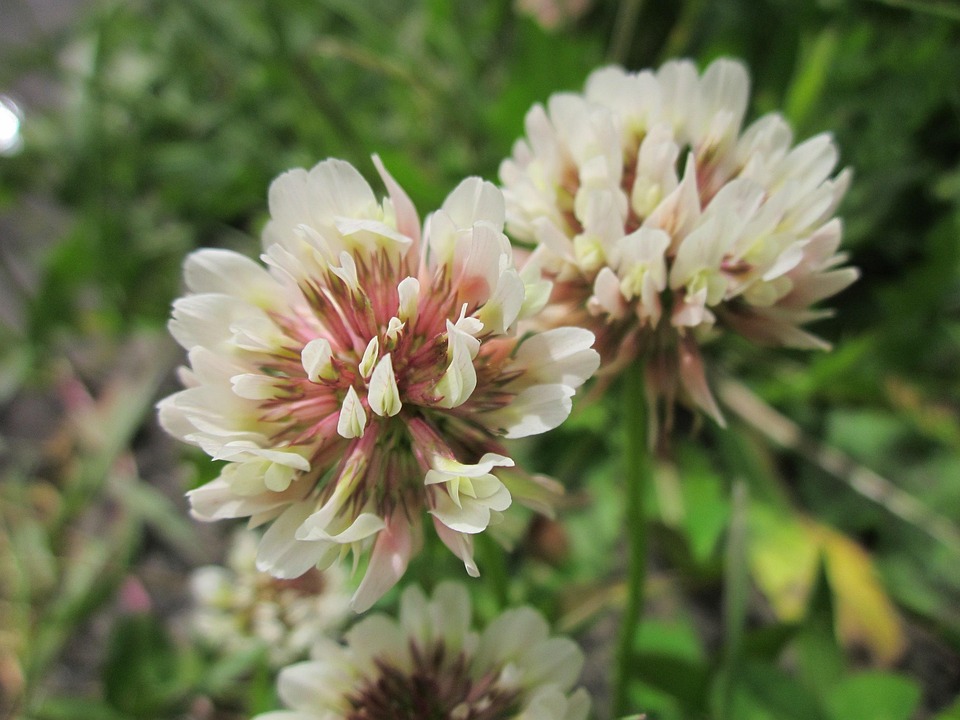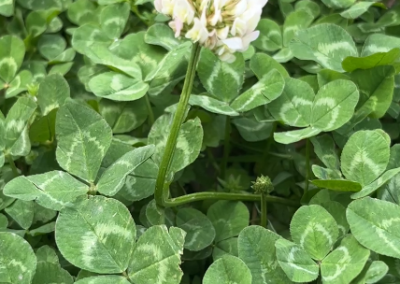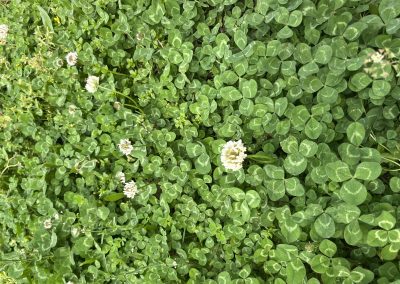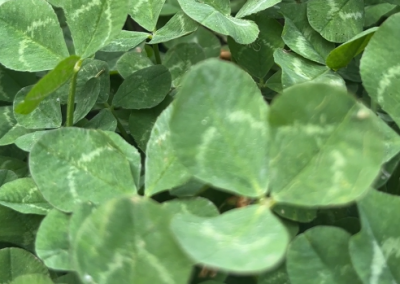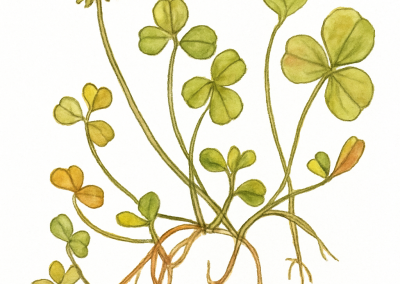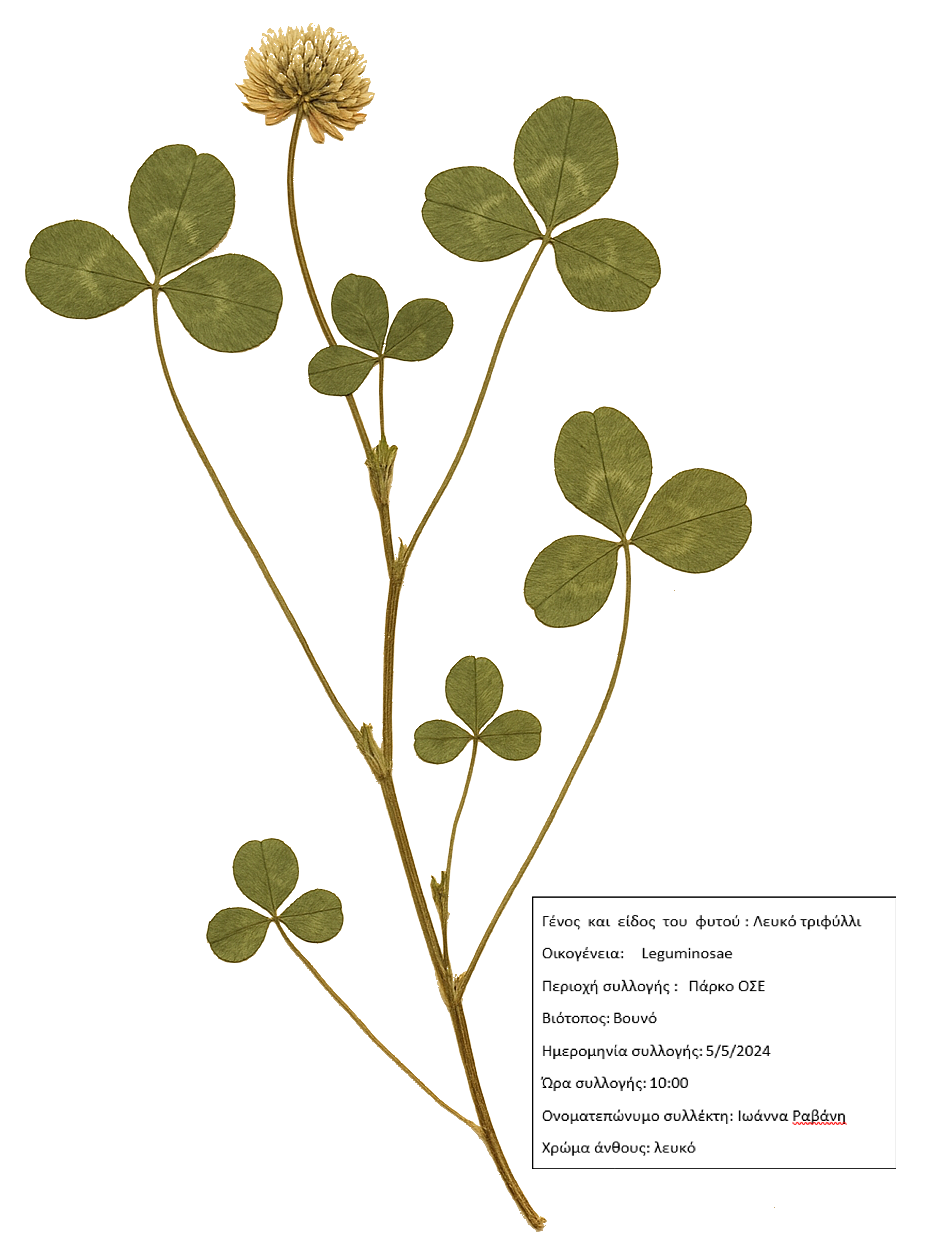Trifolium repens
Scientific description
Scientific name: Trifolium repens L.
Common name: White clover
Kingdom: Plantae
Syntax: Angiosperms
Order: Eudicots, Fabales
Family: Leguminosae
Genus: Trifolium
Species: Trifolium repens
Origin:
Native to Europe and Central Asia; widely introduced worldwide including North/South America, New Zealand, Australia, Africa.
Ecology:
Highly adaptable; found in grasslands, pastures, lawns, gardens, roadsides, agricultural fields. Prefers moist, well-drained soil; tolerates sandy, loamy, clay soils. Full sun to partial shade. Fixes nitrogen via Rhizobium symbiosis, improving soil fertility.
Description:
Herbaceous, perennial, slow-growing. Leaves trifoliate, each leaflet obovate to elliptical with a white/light-green crescent mark, 1–2 cm long. Creeping stems root at nodes, smooth, green to reddish. Produces spherical clusters of small white to pink flowers, 2–3 cm diameter, blooming late spring–early autumn. Shallow fibrous root system forming a dense mat.
Propagation:
By seeds (flower pods with multiple small seeds dispersed by wind, water, animals) or vegetative spreading (creeping stems root at nodes). Seeds germinate in 10–25°C in moist soil.
Uses:
Agricultural/forage: high-protein, improves soil nitrogen, stabilizes soil, erosion control, alternative to lawns (less mowing, irrigation, fertilization). Pollinator support. Medicinal: diuretic, respiratory remedies, teas, salves.
Τριφύλιον το έρπον – Λευκό τριφύλλι
Βασίλειο: Plantae
Συνομοταξία: Αγγειόσπερμα (Angiosperms)
Ομοταξία: Eudicots
Τάξη: Fabales
Οικογένεια: Ψυχανθή (Leguminosae)
Γένος: Trifolium
Είδος: Trifolium repens
Προέλευση:
Ενδημικό στην Ευρώπη και Κεντρική Ασία, εισαχθεί παγκοσμίως (Βόρεια/Νότια Αμερική, Νέα Ζηλανδία, Αυστραλία, Αφρική).
Οικολογία:
Πολύ προσαρμοστικό, σε λιβάδια, βοσκοτόπια, γκαζόν, κήπους, πρανή δρόμων, χωράφια. Προτιμά υγρά, καλά στραγγιζόμενα εδάφη, αντέχει αμμώδη, αργιλώδη. Ήλιος έως μερική σκιά. Δεσμεύει άζωτο μέσω Rhizobium.
Περιγραφή:
Ποώδες, πολυετές, αργής ανάπτυξης. Φύλλα τρίφυλλα, φυλλάρια ωοειδή–ελλειπτικά, με λευκό/ανοιχτοπράσινο ημισεληνοειδές σημάδι (1–2 cm). Βλαστοί έρποντες, ριζώνουν στους κόμβους, λείοι, πράσινοι έως κοκκινωποί. Σφαιρικές συστάδες λευκών/ροζ άνθεων, 2–3 cm, ανθίζουν άνοιξη–φθινόπωρο. Ριζικό σύστημα ρηχό, ινώδες, πυκνό στρώμα.
Πολλαπλασιασμός:
Με σπόρους (λοβοί με πολλούς σπόρους, διάσπαρτοι από άνεμο, νερό, ζώα) ή βλαστικά (έρποντες βλαστοί ριζώνουν στους κόμβους). Βλάστηση σε 10–25°C, υγρό έδαφος.
Χρήση:
Ζωοτροφή, υψηλή πρωτεΐνη, βελτιώνει γονιμότητα εδάφους, σταθεροποίηση εδάφους, έλεγχος διάβρωσης, εναλλακτικό γκαζόν. Στήριξη επικονιαστών. Ιατρική: διουρητικό, αναπνευστικά προβλήματα, αφεψήματα, αλοιφές.
Trifolium repens L (trèfle blanc)
Règne: Plantae
Syntaxe: Angiospermes
Ordre: Eudicots, Fabales
Famille: Légumineuses
Genre: Trifolium
Espèce: Trifolium repens
Origine:
Europe et Asie centrale, introduit et naturalisé mondialement (Amériques, NZ, Australie, Afrique).
Écologie:
Très adaptable; prairies, pâturages, pelouses, jardins, bords de route, champs. Préfère sols humides, bien drainés; tolère sableux, limoneux, argileux. Soleil à mi-ombre. Fixe l’azote via Rhizobium.
Description:
Plante herbacée vivace, croissance lente. Feuilles trifoliées, folioles obovales–elliptiques avec marque croissant blanc/vert clair, 1–2 cm. Tiges rampantes, enracinent aux nœuds, lisses, vertes à rougeâtres. Inflorescences sphériques blanches/rosées, 2–3 cm, floraison fin printemps–début automne. Racines superficielles, fibreuses, tapis dense.
Propagation:
Graines (gousses contenant plusieurs petites graines, dispersées par vent, eau, animaux) ou végétative (tiges rampantes enracinent aux nœuds). Germination 10–25°C, sol humide.
Utilisation:
Fourrage riche en protéines, améliore fertilité du sol, stabilise sol, lutte contre l’érosion, alternative pelouse, soutien pollinisateurs. Médecine traditionnelle: diurétique, voies respiratoires, tisanes, onguents.
Trifolium repens L.
Denumire comună: Trifoi alb
Regn: Plantae
Grup: Angiosperme
Cladă: Eudicote
Ordin: Fabales
Familie: Leguminosae (Fabaceae)
Gen: Trifolium
Specie: Trifolium repens
Origine:
Europa și Asia Centrală; naturalizat global (America de Nord/Sud, NZ, Australia, Africa).
Ecologie:
Adaptabil, pășuni, peluze, grădini, margini drum, teren agricol. Soluri umede, bine drenate, tolerează nisipoase, lutoase, argiloase. Soare plin–semi-umbră. Fixează azot prin Rhizobium, crește fertilitatea solului.
Descriere:
Plantă erbacee, perenă, creștere lentă, tulpini târâtoare. Frunze trifoliate, foliola obovată–eliptică, semilună alb/verde deschis, 1–2 cm. Tulpini netede, verzi–roșiatice, înrădăcinează la noduri. Inflorescențe sferice albe/rozalii, 2–3 cm, înflorire sfârșit primăvară–început toamnă. Rădăcini superficiale, fibre, covor dens.
Înmulțire:
Semințe (păstăi cu multiple semințe, dispersate vânt/apă/animale) sau vegetativ (tulpini târâtoare înrădăcinează la noduri). Germinare 10–25°C, sol umed.
Utilizări:
Furaj, bogat în proteine, fertilizează solul, stabilizează sol, controlează eroziunea, alternativă la gazon, sprijin pentru polenizatori. Medicinal: diuretic, afecțiuni respiratorii, ceaiuri, unguente.
Creative writing inspired by Trifolium repens
Trifolium repens — White Clover
Long ago, in the verdant meadows of ancient Greece, there lived a young shepherdess named Thalia, who was known for her deep connection to the earth. She spent her days wandering the rolling hills, tending her sheep and learning the secrets of the land. Her favorite companion was a small, creeping plant with delicate three-leafed clusters—the clover. Thalia believed this humble plant was a gift from the gods, a symbol of harmony between nature and life.
One spring, a great drought threatened the land, and all the plants began to wither under the scorching sun. Desperate to save her flock and the land she loved, Thalia prayed to the earth goddess Demeter, begging for relief. Moved by her devotion, Demeter appeared before her, disguised as an old woman. She instructed Thalia to seek out the elusive four-leafed clover, a rare and powerful symbol of luck and protection.
For days, Thalia scoured the fields, searching tirelessly for this rare variation of her beloved plant. On the seventh day, she finally found one, its four leaves shimmering like emeralds in the sunlight. As soon as she plucked the clover, a cool breeze swept through the fields, and the rains began to fall, restoring life to the earth.
In gratitude, Demeter blessed the plant, ensuring that it would grow abundantly and protect all who found it. The three-leaf clover, or Trifolium repens, became a symbol of unity, hope, and protection, while the elusive four-leaf clover carried the promise of divine favor.
From that day forward, people believed that clovers brought balance and harmony to the land. Thalia's name was remembered in the whisper of the wind through the meadows, and the clover became known as a plant of peace and prosperity.


